DRIVER_IRQL_NOT_LESS_OR_EQUAL is an error that appears on a blue screen with the stop code 0x000000D1. This Windows error usually appears when your system's built-in drivers, mostly network adapters, use an incorrect memory address while executing their task. Other than this, it also appears for many other reasons:
- 🚫Corrupted System Files
- 🖥️Faulty System Hardware & Software
- ❌RAM Issues
- 🛠️Antivirus Software
- 👿Viruses & Malware
- 😢Bugs & Glitches In the System
So, if you also get the DRIVER_IRQL_NOT_LESS_OR_EQUAL error on your Windows system, we've got you covered. This tutorial will explain how you can resolve the DRIVER_IRQL_NOT_LESS_OR_EQUAL error. So read ahead and learn to fix it.
| Workable Solutions | Step-by-step Troubleshooting |
|---|---|
| Method 1. Check Computer's Hardware and Software | One of the most common causes of the DRIVER_IRQL_NOT_LESS_OR_EQUAL...Full steps |
| Method 2. Uninstall Network Drivers in Device Manager | Press the Windows + R keys simultaneously to open the Run program on your system...Full steps |
| Method 3. Update, Uninstall, or Reinstall Device Drivers | Open the Device Manager utility on your Windows system using your preferred method...Full steps |
| Method 4. Use the Scannow Command To Repair Driver | Press the Windows key to open the search box and type the command prompt in it...Full steps |
| More Methods to Fix DRIVER_IRQL_NOT_LESS_OR_EQUAL | Open Windows Search using the Windows + S keys and type in Memory Diagnostic...Full steps |
Recover Data When Encounter DRIVER_IRQL_NOT_LESS_OR_EQUAL
DRIVER_IRQL_NOT_LESS_OR_EQUAL error is a critical BSOD error that can result in data loss. Or you may encounter other BSOD errors like Windows stop code 0xC000021A. If this happens to you due to this error, and you want to get all your data back into your Windows PC, then you can take the help of EaseUS Data Recovery Wizard.
EaseUS Data Recovery Wizard enables you to recover deleted files from Windows 10 or 11 due to accidentally deleting, formatting the wrong partition, sudden system crash, malware attack, etc., from your PC. The highlighting part about this is that it can recover all file types, like images, documents, videos, audio, archives, emails, etc. You can also recover data from a hard drive that won't boot.
If your images and videos get corrupted while troubleshooting this BSOD error, you can easily use EaseUS Data Recovery Wizard to repair them. So, check the below-mentioned instructions to learn to recover lost or deleted files using our tool:
Step 1: Install and Launch EaseUS Data Recovery Wizard
Download and install the recovery software from the EaseUS official website, then open it on your computer or laptop.
Step 2: Scan and Select Deleted Files
Choose the hard drive or partition where the deleted files located and click "Search for Lost Data". After scanning, preview and select the deleted files you want to recover.
Step 3: Choose Location and Recover Deleted Files
Click "Recover" and choose a location to save the files (preferably on a different drive), and click "OK." Check the recovered files in the chosen folder.You can choose a cloud storage, such as OneDrive, Google Drive, etc., and click "Save" to save your recovered files.
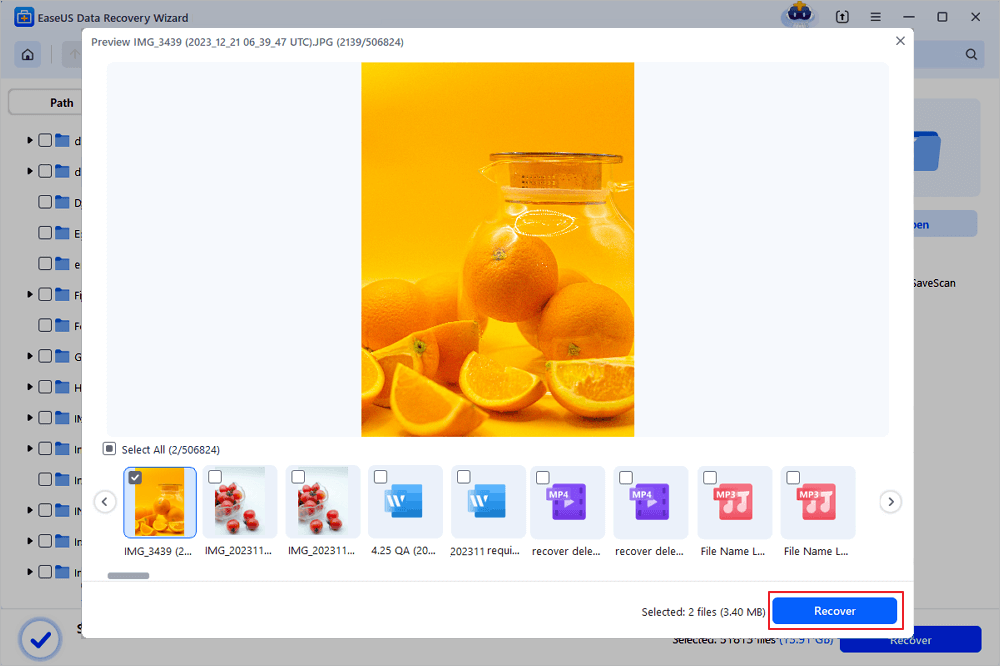
Don't forget to share this page on your social media so you can easily find this page!
How To Fix DRIVER_IRQL_NOT_LESS_OR_EQUAL [10 Ways]
Here are some working fixes to fix the DRIVER_IRQL_NOT_LESS_OR_EQUAL error in Windows. You can check the detailed tutorial of each method:
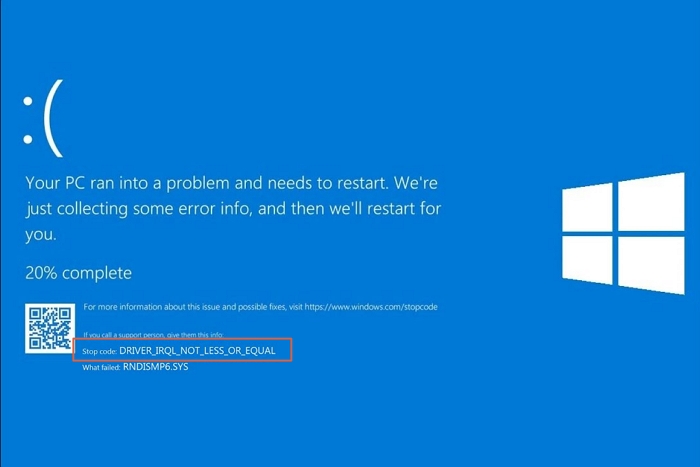
Method 1. Check Computer's Hardware and Software
One of the most common causes of the DRIVER_IRQL_NOT_LESS_OR_EQUAL error is the issues with the computer's hardware and programs installed on it. So, we suggest you check your system's RAM sticks to ensure they're in perfect condition and properly connected. You can also try cleaning the RAM Sticks using a dry cloth with gentle hands.
Also, unplug all the connected external devices, like USB drives, hard drives, printers, etc., and restart your system to check if an external device is causing it.
If you started getting this BSOD error after installing a program on your system, ensure it's compatible with your current Windows 11/10 system. If you aren't unsure about it, uninstall it.

Method 2. Uninstall Network Drivers in Device Manager
As outdated network drivers could also be the reason for this BSOD error, we suggest you reinstall them. Doing so will eliminate bugs and glitches with the network drivers and the error. We've mentioned the step to uninstall network drivers in Windows 11/10 below:
Step 1. Press the Windows + R keys simultaneously to open the Run program on your system.
Step 2. Type devmgmt.msc in Run's search and press Enter to open Windows Device Manager.

Step 3. Expand the Network Adapters section in the Device Manager program by double-clicking on it.
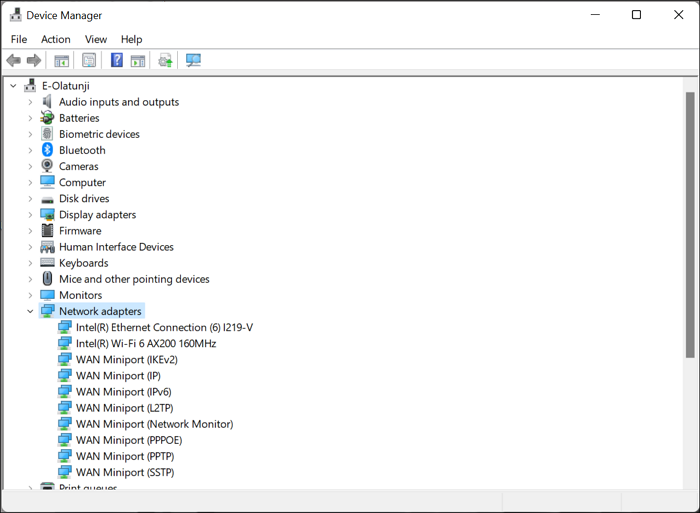
Step 4. Right-click on the network adapter in the Network Adapters section.
Step 5. Select "Uninstall device" from the menu to uninstall it from the system.

Step 6. Press the Alt + F4 keys, select the "Restart" option in the Shut Down Windows prompt, and press Enter to restart Windows 11/10 and reinstall the driver.

Method 3. Update, Uninstall, or Reinstall Device Drivers
The DRIVER_IRQL_NOT_LESS_OR_EQUAL error also appears because of issues with the system driver. To check whether a system driver is causing this issue in your case, we suggest you update and reinstall all your system drivers. So try the same by following the below-mentioned steps:
Update the Driver:
Step 1. Open the Device Manager utility on your Windows system using your preferred method.
Step 2. Expand any section in Device Manager and right-click on any driver.
Step 3. Choose "Update driver" from the popup menu and select "Search automatically for drivers" in the next window.

Step 4. Let the system search for new updates for the driver, and hopefully, the issue will get fixed.

Reinstall the Driver:
Step 1. Right-click on the system driver, and choose the "Uninstall device" option from the right-click menu.
Step 2. Once it's uninstalled, click "Action" in the top menu, and select the "Scan for hardware changes" option from the dropdown to reinstall it on the system.

Method 4. Use the Scannow Command To Repair Driver
It could be possible that your Windows system's critical files have been corrupted, which is why this BSOD error appears on the system. In that case, we suggest you run the SFC Scannow command to repair Windows 11 and all the corrupted system files. You can do the same by following the below-mentioned instructions:
Step 1. Press the Windows key to open the search box and type the command prompt in it.
Step 2. Select the "Run as administrator" option from the search results to open it with admin privileges.

Step 3. Type the sfc /scannow command in the console to start the SFC scan.
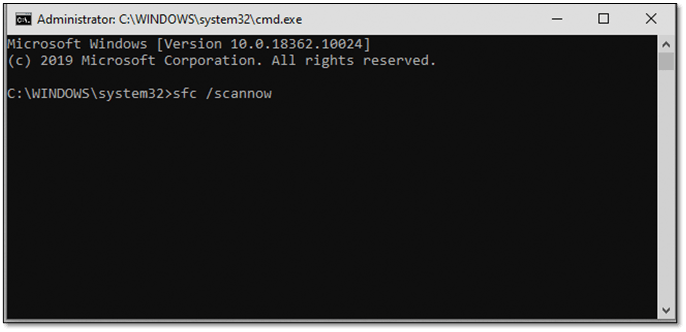
Step 4. Wait for the SFC scan to finish. Once completed, restart your system and check the issue's status. You can learn more about repairing drive errors by reading the following passage:

Fixed: Restart to Repair Drive Errors on Windows 10
Have you ever encountered the Restart to repair drive errors on Windows 10 or Windows 11? Read more >>
Method 5. Fix Driver Errors With Windows Memory Diagnostic Tool
The DRIVER_IRQL_NOT_LESS_OR_EQUAL error also appears because of system RAM or memory errors. In that case, we suggest you use the Windows Memory Diagnostic tool to repair all the errors with your RAM and check if doing so fixes the issue.
So check the below-listed instructions to run the Memory Diagnostic tool on your Windows PC:
Step 1. Open Windows Search using the Windows + S keys and type in Memory Diagnostic.
Step 2. Select "Windows Memory Diagnostic" from the Best Match section in the results to open it.

Step 3. Click on "Restart now and check for problems" in the Windows Memory Diagnostic window.
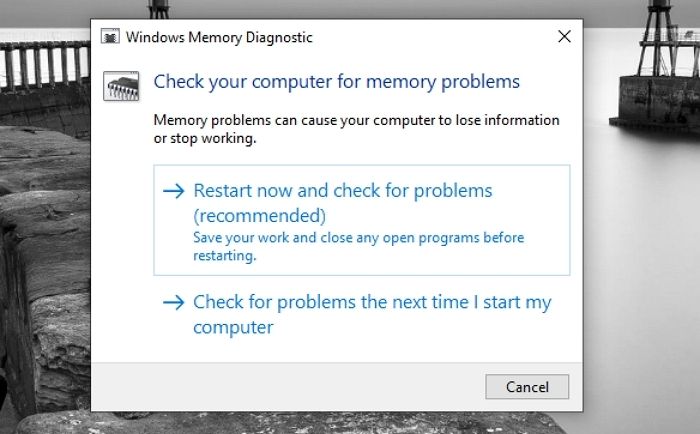
Step 4. After doing so, your system will restart, and two scans will start with the intent to fix issues with RAM.
Method 6. Remove Computer Viruses and Malware
Another effective way to fix this BSOD error is to run a quick virus scan on your Windows PC. This is because Malware and viruses in the system can also cause this BSOD error. You can try the below prompts to run a quick virus scan on your Windows PC:
Step 1. Open the Windows Search Box, type in Virus & threat protection, and select it from the results.
Step 2. On the next window, click the "Quick Scan" button to start a virus scan to search for malicious files.

Step 3. Once the scan is completed, check if it found any suspicious files on your system. If yes, follow the on-screen prompts to remove them from the system. You can learn more about how to remove viruses without antivirus software by reading the following article:

Delete and Remove Virus Without Antivirus
This tutorial shows how to remove viruses from laptop viruses. You can remove viruses without running antivirus software. Read more >>
Method 7. Update Your Windows OS
Microsoft suggests its users update their Windows 11/10 PC or laptop to avoid these BSOD errors. Thus we suggest you check whether your system is up-to-date. If it isn't, update it to fix all the bugs in the system. By the way, you should back up essential data first. If you lost data without any backup, EaseUS Data Recovery Wizard could recover lost files after Windows 11 update.
So do the same by trying the below steps:
Step 1. Open the Settings app on your system and go to the Windows Update section from the left menu.
Step 2. Click the "Check for updates" button at the top to search for new updates for your current OS build.

Step 3. If it finds some new updates to install, click the "Download and Install all" button to install them.
Step 4. Once done, click on "Advanced options" under More Options.

Step 5. Click on "Optional updates" in the "Additional Options" section to view the optional updates.

Step 6. Look for the driver-related updates in the Driver Updates section and tick the boxes next to them.
Step 7. Click the "Download and Install" button to download and install all the optional updates.

Once done, restart your system and check if the DRIVER_IRQL_NOT_LESS_OR_EQUAL error is gone. You can share this page with more users to help them solve this problem.
Method 8. Use Windows Get Help Utility
Windows has an integrated Get Help app that lets you find solutions to your Windows problems. If the issue persists, we suggest you use your PC's built-in Get Help app to fix DRIVER_IRQL_NOT_LESS_OR_EQUAL. You can follow the below-mentioned prompts to know how to resolve it on your system using the Get Help app:
Step 1. Open the Get Help app using the Windows Search Box on your Windows system.
Step 2. Type Troubleshoot BSOD error in the Get Help app's search box and press Enter.
Step 3. You need to answer now the questions asked to get the resolution for this error.

Method 9. Use System Restore
If you're still getting the DRIVER_IRQL_NOT_LESS_OR_EQUAL error on your PC, you can try to restore computer to an earlier date. So if you already have a system restore point created, follow the below-mentioned steps to go back to it and fix the issue:
Step 1. Open the Windows Search Box, type "create a restore point" in it, and click on it in the results.
Step 2. Click the "System Restore…" button under "System Restore" and click the Next > button.
Step 3. Select the restore point to which you want to revert your system and click on the Next > option.

Step 4. Click the Finish button to return your PC to the selected system restore point.
Check the following passage to fix system restore initializing issues on Windows:

6 Ways to Fix System Restore Is Initializing in Windows 11/10
Sometimes, System Restore may get stuck and show System Restore is Initializing on the screen when you try to restore files for your computer. Read more >>
Method 10. Factory Reset Your Windows OS
The last thing you can do to fix the DRIVER_IRQL_NOT_LESS_OR_EQUAL error is to reset the system. Doing so will revert your system's settings to default.
Also, you need to delete all the data from your system to make sure nothing is there on your system that can cause this issue. So follow the mentioned steps to reset your PC:
Step 1. Open the Settings app on your Windows 11 PC and go to the Recovery section of it.
Step 2. Click the Reset PC button under the Recovery options section in the Recovery window.

Step 3. Select the "Remove everything" option in the Choose an option window and click on Cloud download.

Step 4. You need to follow now the on-screen steps to reset your system.
If you want to recover lost files after Windows factory reset, you can check this page:

How to Recover Files After Factory Reset Windows 10/11
How to recover files after factory reset Windows 10? You can recover files after factory reset on Windows 10 or Windows 11. Read more >>
Summary
You're working peacefully on your system, a sudden system crash happens, and the DRIVER_IRQL_NOT_LESS_OR_EQUAL error appears on the screen. We know how irritating it can be to get this error while working. We shared several working solutions in this troubleshooting guide to fix this error.
We hope this guide helped you fix the error without losing any data. If you lost some of your stored data during troubleshooting, consider using EaseUS Data Recovery Wizard to recover it.
DRIVER_IRQL_NOT_LESS_OR_EQUAL FAQs
Many people get different questions about the DRIVER_IRQL_NOT_LESS_OR_EQUAL error on Windows. Thus, we've answered some commonly asked questions about this error in this section. Read the mentioned questions and learn more about this BSOD error in detail:
1. How to fix the Kernel Mode Heap Corruption error?
An easy way to fix the Kernel Mode Heap Corruption error is to repair corrupted system files by running the SFC scan in the console. You can also try fixing this error by updating all the system drivers to the latest build to eliminate all the bugs and glitches.
2. What does DRIVER_IRQL_NOT_LESS_OR_EQUAL mean?
DRIVER_IRQL_NOT_LESS_OR_EQUAL means there's something wrong with your system's drivers, especially network adapters, RAM issues, faulty hardware, antivirus app, etc. Fortunately, troubleshooting can fix it, like updating and reinstalling network drivers.
3. How to fix DRIVER_IRQL_NOT_LESS_OR_EQUAL on Windows 11?
One of the effective workarounds to fix DRIVER_IRQL_NOT_LESS_OR_EQUAL on Windows 11 is to reinstall and update the system's network adapters. You can also try running an SFC scan on your Windows PC, as corrupted system files could cause this error.
4. Can I recover data from a BSOD computer?
You can recover data from a BSOD-affected Windows computer using a third-party data recovery tool. Plenty of excellent data recovery tools let you do the same. You can recover all file types, like images, videos, documents, audio, archives, and other files, with EaseUS Data Recovery Wizard.
Was This Page Helpful?
Dany is an editor of EaseUS who lives and works in Chengdu, China. She focuses on writing articles about data recovery on Mac devices and PCs. She is devoted to improving her writing skills and enriching her professional knowledge. Dany also enjoys reading detective novels in her spare time.
Related Articles
-
Fix Windows 10 Doesn't Recognize or Detect Second Hard Drive Error
![author icon]() Tracy King/2024-07-24
Tracy King/2024-07-24 -
How to Turn off The Firewall in Windows 10 [A Complete Guide]
![author icon]() Daisy/2024-01-11
Daisy/2024-01-11 -
Ghost of Tsushima Director's Cut Save File Location - How to Find & Backup?
![author icon]() Jerry/2024-08-19
Jerry/2024-08-19 -
Valorant Not Opening Windows 11 [SOLVED]
![author icon]() Dany/2024-08-20
Dany/2024-08-20
EaseUS Data Recovery Services
EaseUS data recovery experts have uneaqualed expertise to repair disks/systems and salvage data from all devices like RAID, HDD, SSD, USB, etc.
